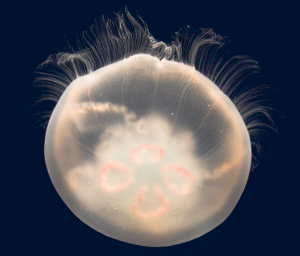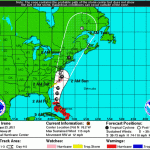
Why send jellies to space? Well, because it’s awesome (true for anything in space), but mostly because of little crystals jellies keep in their bodies, and what these crystals can tell us about long-term human space travel.
When a jelly grows, it forms calcium sulfate crystals at the margin of its bell [1]. These crystals are surrounded by a little cell pocket, coated in specialized hairs, and these pockets are equally spaced around the bell. When jellies turn, the crystals roll down with gravity to the bottom of the pocket, moving the cell hairs, which in turn send signals to neurons. In this way, jellies are able to sense up and down. All they need is gravity.
Humans have gravity sensing structures too, and therein lies the crux: in space with no gravity, will these structures grow normally? If humans ever want to travel to deep space, we’ll need to be popping out kids while up there. Will these kids develop normal gravity sensing, even after growing up without it?
For jellies at least, things aren’t so good. After developing in space, astronaut jellies have a hard life back on Earth. While development of the sensory pockets appears normal, many more jellies had trouble getting around once on the planet, including pulsing and movement abnormalities, compared to their Earth-bound counterparts [2, 3].
Human gravity sensing isn’t exactly like that of jellies, but it’s close. The human inner ear contains both fluids and small crystals, which tell us not only the angle of our head, but also our forward momentum. Even with these differences, there is enough similarity between the two systems to be cause for concern. In other words, if jelly babies have trouble gravity sensing on Earth after being in space, human babies may be fucked.
As anyone who’s suffered from vertigo will tell you– not being able to orient yourself in space is majorly distressing. I know: I once rode the gravitron eight times in a row. Messing with gravity by spinning really fast was the best thing ever to my middle school brain. The following day, however, I woke up and promptly ran into a wall. I had centripetal-forced myself so much that “straight” became “slight right”. This lasted 3 days and was completely terrible. And that’s just three days. Human births in space could mean a lifetime of Earthly confusion.
Of course, I still think space is amazing and weightlessness is still #1 on my bucket list, but the jellies don’t lie. Long term space travel will be fraught with developmental challenges to the babies growing onboard. If the jellies say growing up in space isn’t so great, we better be listening.
Work cited:
[1] Calcium sulfate hemihydrate is the inorganic mineral in statoliths of Scyphozoan medusae (Cnidaria)
http://pubs.rsc.org/en/content/articlelanding/2005/dt/b416246c
[2] Graviceptor development in jellyfish ephyrae in space and on Earth.
http://www.ncbi.nlm.nih.gov/pubmed/11537934
[3] Development studies of Aurelia (Jellyfish) ephyrae which developed during the SLS-1 mission
http://www.sciencedirect.com/science/article/pii/0273117794904081





This is why we need to spin any ship/station to simulate gravity!! it’s not that hard, just need to make these things a little bigger.
We can’t make artificial gravity that is perfect. EX. inside of the fast spinning hamster wheel design that you were talking about if you drop an object it would not go down it would go extremely fast right or left depending on which way the wheel was spinning, and well thats not a good thing. What you were suggesting would also cost a crazy amount.